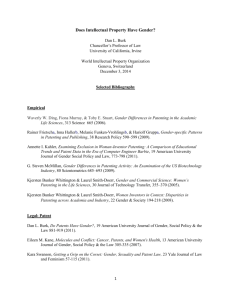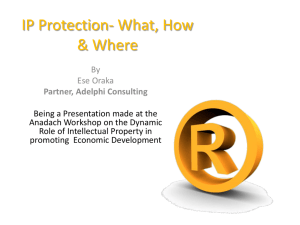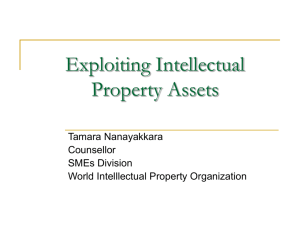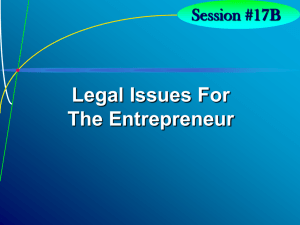Intellectual Property and Economic Development: some key issues
advertisement
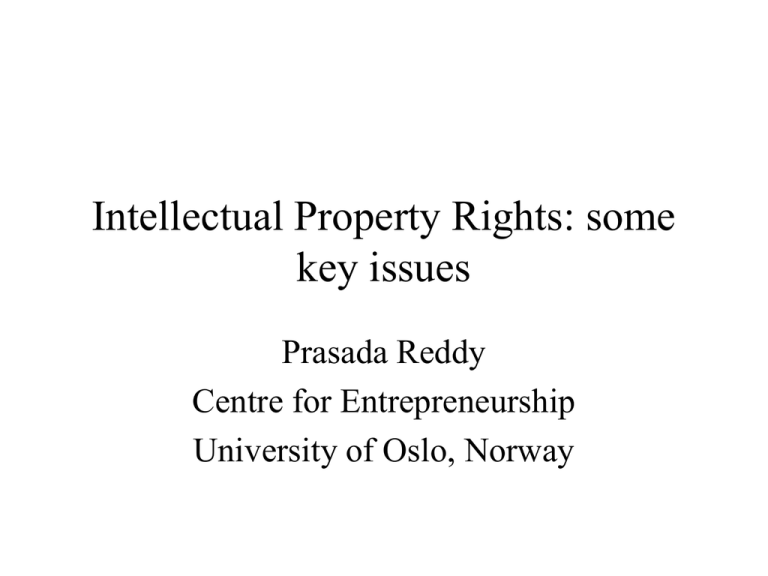
Intellectual Property Rights: some key issues Prasada Reddy Centre for Entrepreneurship University of Oslo, Norway What is intellectual property (IP)? • IP as a term describes the ideas, inventions, artworks, music and literature that are basically intangible in creation. • IP is the commercial application of imaginative thought to solving a technical or artistic challenge. • IP is not the product itself, but the idea behind it, the way the idea is expressed, and distinctive way it is named and described. What is IP 2 • IP contains the word ‘property’ denoting its value and its application only to inventions, works and names for which an individual or group of people claims ownership. • Ownership is important as potential economic gains act as a powerful driving force to innovate. Historical context of IP 1 • Ancient traders from China, Egypt and India used logos to distinguish their products from others. • The Venetian Law of 1474 - first systemic way of protecting inventions by a form of patent. • 16th Century Tudor England - the Statue of Monopolies in 1624 was the first written law providing for the grant of a monopoly for an invention for a limited period of time. • France 1791, USA 1788. Historical context of IP 2 • Invention of movable type printing press by Johannes Gutenberg around 1440, facilitated copying of books, which were previously copied by scribes. • Restrictions imposed the Roman Catholic Church on printing of books by reformers. • Monopolies of the press in England and France. • The Statue of Anne enacted by the British Parliament reduced monopoly powers of the press and recognized the rights of authors and their heirs. Early international treaties 1 • Flourishing economies of the European countries in the second half of 19th century created crossborder trade and investments. • International Exhibition of Inventions in Vienna in 1873 - foreign exhibitors refused to attend for the fear of their ideas getting copied and commercialized in other countries. • Paris Convention for the Protection of Industrial Property in 1883. Early international treaties 2 • Mid-1800s - renowned authors works illegally reproduced for sale in other countries. • Establishment of International Literary Association by Victor Hugo and others, which became International Literary and Artistic Association. • Berne Convention for the Protection of Literary and Artistic works in 1886. • Principle of international treaties is the ‘national treatment’. Types of IP • Industrial Property - Patents, Trademarks • Literary and Artistic works - Literature, Paintings and Music. Convention of WIPO in 1967 • Literary, artistic and scientific works • Performance of performing artists, phonograms, and broadcasts • Inventions in all fields of human endeavor • Scientific discoveries • Industrial designs • Marks and commercial names and designations • Protection against unfair competition Technology and Economy 1 • The law of diminishing returns • Endogenous growth theories - technological change is included in the capital and labor stock. • Exogenous growth theories - technological change increases output, but source unknown. Technology and Economy 2 • Schumpeter - innovations and entrepreneurs lead the economic growth. Some degree of monopoly required to spur innovation and entrepreneurship. • Robert Solow 1956: Between 1909 and 1949 growth in capital and labor accounted for only half of the growth in total GDP of the US. The rest Solow residual. • Technology as exogenous factor and economic policy cannot influence it, but visa versa is possible. Technology and Economy 3 • Paul Romer 1986 - accumulation of knowledge as the driving force behind economic growth. • Technological progress in industry requires concerted, profit-oriented activity that yields two components: 1) specific technical features embodied in products that can be patented and produced, excluding rivals from the same activity; 2) the knowledge that those features were essentially for the public good. • Encourage R&D and subsidize human capital. Economic rationale for an IP system • Provides motivation to innovators by granting them temporary monopoly rights. • Disclosure of technical details would lead to wider diffusion of technology after the patent expiry. • Leads to early disclosure of technical information that would facilitate further innovations. • Reduces consumer search costs (e.g. trademarks) • Encourages producers to deliver qualitative and high performance goods and services, increasing consumers welfare. Basic functions of an IP system • Facilitate IP CREATION (e.g. patent databases as sources of innovative ideas) • Provide IP PROTECTION (e.g. protection from illegal reproduction and loss of profits) • Support IP APPROPRIATION (e.g. higher profits with innovative products, establish good will and reputation in the market and provides value & tradability) • Prevent IP ABUSES (e.g. unfair competition) Firms-level IP strategies 1 • i) Technology-related – Facilitates alliances with other firms. Patent searches will enable firms to identify technology trends and alternative sources of technologies; • ii) Finance-related – Provides access to venture capital and other capital resources; • iii) Market-related – Provides a distinctiveness to its products (knowledge/technology) and also helps in assessing competition. Firms-level IP strategies 2 • Pro-active strategies • Preventive strategies • Portfolio of IPRs (Apple iPod case) Intellectual Property Rights • • • • • • • Patents (Utility & Design) Plant varieties Semiconductor designs Trade secrets Trademarks (Service marks, Collective marks) Geographical indicators Copyrights & Related rights Patents 1 • • • • • • Patentability: Novelty Non-obviousness Industrial application Issues of Prior Art Issues of Research Exemptions Patents 2 • • • • • Non-Patentable: Innovation vs. Discovery Surgical procedures Mathematical formula (software??) Business methods (exceptions digital methods – single click method for Amazon) • Living beings (exceptions genetically modified versions) Trade Secrets • Secrecy is a state of being concealed or maintained as a secret • Known to only a few people and withheld from general knowledge (only two people know CocaCola syrup formula) • Two conditions for protection: 1) it provides a competitive advantage, and 2) it is maintained as a secret by the firm. • Non-disclosure agreements Trademarks • Distinctive word, name, symbol, slogan, shape, sound, smell or logo or movement that identifies the source of a product or service. • Danger of trademark becoming a generic name (e.g. Jeep). • Franchising of trademarks • Trademarks and Parallel Trade Trademarks 2 • • • • • • • • Brand values: 1) Coco-Cola – USD 67 b. 2) Microsoft – USD 57 b. 3) IBM – USD 56 b. 6) Nokia – USD 30 b. 7) Toyota – USD 28 b. 9) McDonalds – USD 27 b. Interbrands Annual Ranking 2006 Copyrights & Related Rights • Protection to authors, composers and artists relating to the FORM OF EXPRESSION rather than the SUBJECT MATTER. • Related rights (e.g. screen play writers, actors, broadcasters, etc.) New technologies and IP system • Problems in applying old IP concepts to emerging technologies. • Patenting of software • Patenting of business methods • Patenting of living organisms • Trademark vs domain name • Patenting of public knowledge National IP systems and global business • International Conventions - Paris, Berne, Madrid, Washington, etc. • World Intellectual Property Organization (WIPO) as an arbitrator in some cases • E-commerce • Patent Cooperation Treaty (PCT) • Trade-related Intellectual Property Rights (TRIPS) TRIPS Agreement • • • • • Minimum standards Inclusion of new areas for patenting Restrictions on compulsory licensing TRIPS and access to medicines Parallel imports

